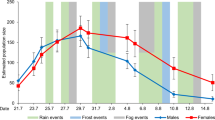Summary
-
1.
Four groups of 75 pairs each of marked adultDacus tryoni that had emerged from field-collected guavas were liberated into cage-covered guava trees at the end of May, 1960 and sampled at weekly intervals to estimate the overwintering survivorship.
-
2.
Estimates of numbers were made using three different methods as described byLeslie (1952) and one byJolly (1965). The Method A, approximate Method B andJolly models gave quite similar results although the Method A model was shown to be more sensitive to stochastic changes in theR/r ratios. The complete Method B model produced much smaller variances, due to its full utilization of the information in the data but it was very sensitive to small biases—even those caused by the restriction that recaptures must be whole numbers—and thus could not quite approach the exact expectations.
-
3.
Although in some instances, statistical tests (Leslie, 1958) showed some significant deviations from randomness in recapture, these were not appreciable and did not affect the estimates.
-
4.
When sufficient food was available, the flies in the field cages exhibited survival rates during the winter months of 1960 quite comparable to those of laboratory flies kept at room temperature with several exceptions: (a) there was a high mortality among the newly emerged flies during the initial week after release, (b) a high mortality during the last week of June and (c) a high mortality during the third week in July and the end of August which can be correlated with lack of rain, low humidity and warm daytime temperatures. Low temperatures apparently had little effect on survival.
-
5.
There was no difference in the survival of males and females.
-
6.
One replicate cage, whose flies had been anesthetized with carbon dioxide prior to release, exhibited significantly higher mortality rates than the other replicates.
-
7.
Data from a fifth cage indicated that females were not inseminated during the winter months and did not produce mature eggs until the beginning of September.
Similar content being viewed by others
References
Bailey, N. T. J. (1952) Improvements in the interpertation of recapture data.J. Anim. Ecol. 21: 120–127.
Bateman, M. A. andF. J. Sonleitner (1967) The ecology of a natural population of the Queensland fruit fly,Dacus tryoni. I. The parameters of the pupal and adult populations during a single season.Aust. J. Zool. 15: 303–335.
Chapman, D. G. (1948) A mathematical study of confidence limits of salmon populations calculated from sample tag ratios.International Pacific Salmon Fisheries Commission Bulletin II (2): 69–85 (New Westminster, B. C., Canada).
Cochran, W. G. (1954) Some methods for strengthening the common χ2 tests.Biometrics 10: 417–451.
DeLury, D. B. (1951) On the planning of experiments for the estimation of fish populations.J. Fish. Res. Bd. Canada 8: 281–307.
Dowdeswell, W. H., R. A. Fisher andE. B. Ford (1940) The quantitative study of populations in the Lepidoptera. I.Polyommatus icarus Rott.Ann. Eugen. 10: 123–136.
Jolly, G. M. (1965) Explicit estimates from capture-recapture data with both death and immigration-stochastic model.Biometrika 52: 225–247.
Leslie, P. H. (1952) The estimation of population parameters from data obtained by means of the capture-recapture method. II. The estimation of total numbers.Biometrika 39: 363–388.
Leslie, P. H. (1958) Statistical appendix. InOrians, G. H. (1958) A capture-recapture analysis of a shearwater population.J. Anim. Ecol. 27: 71–86.
Solal, R. R. andF. J. Rohlf (1969)Biometry. Freeman, San Francisco.
Sonleitner, F. J. andM. A. Bateman (1963) Mark-recapture analysis of a population of Queensland fruit fly,Dacus tryoni (Frogg.) in an orchard.J. Anim. Ecol. 32: 259–269.
Turner, F. B. (1960) Tests of randomness in recaptures ofRana p. pretiosa.Ecology 41: 237–239.
Author information
Authors and Affiliations
Rights and permissions
About this article
Cite this article
Sonleitner, F.J. Mark-recapture estimates of overwintering survival of the Queensland fruit fly,Dacus tryoni, in field cages. Res Popul Ecol 14, 188–208 (1973). https://doi.org/10.1007/BF02518843
Issue Date:
DOI: https://doi.org/10.1007/BF02518843




